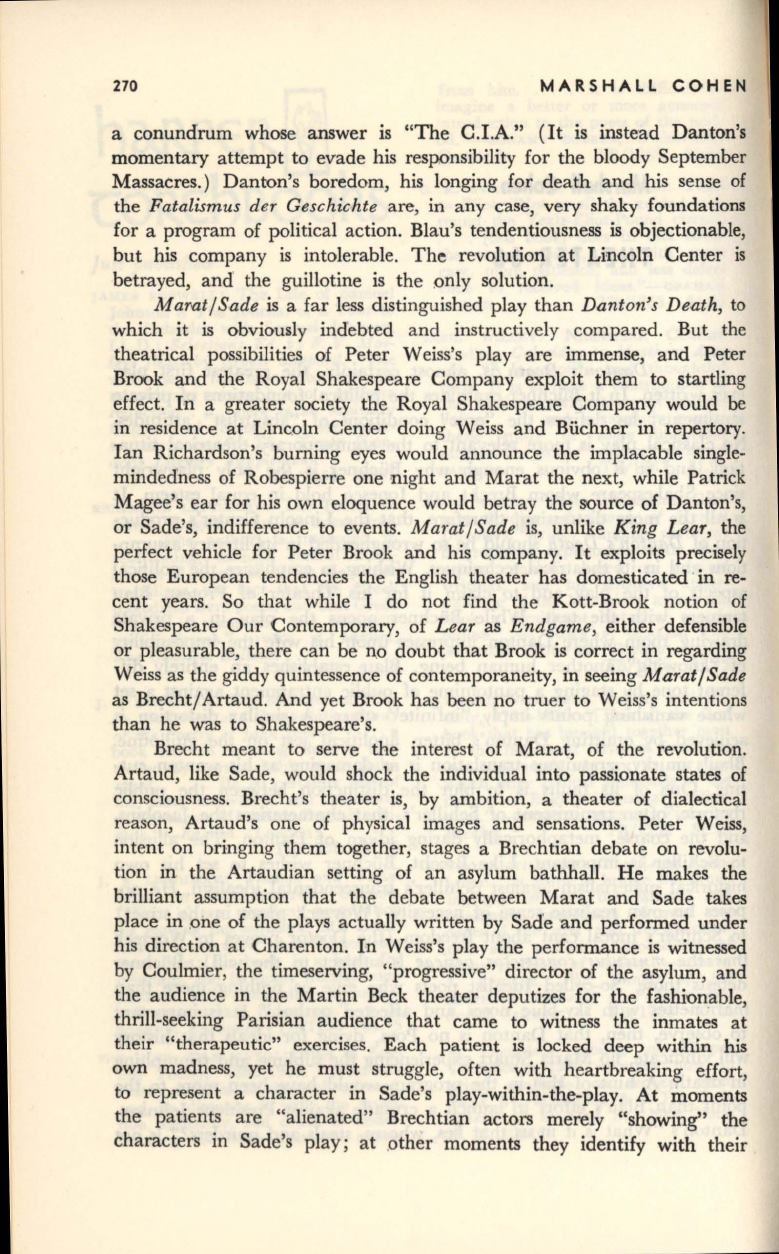
270
MARSHALL COHEN
a conundrum whose answer is "The C.I.A." (It is instead Danton's
momentary attempt to evade his responsibility for the bloody September
Massacres.) Danton's boredom, his longing for death and his sense of
the
Fatalismus der Geschichte
are, in any case, very shaky foundations
for a program of political action. Blau's tendentiousness is objectionable,
but his company is intolerable. The revolution at Lincoln Center is
betrayed, and the guillotine is the only solution.
Marat/Sade
is a far less distinguished play than
Danton's Death,
to
which it is obviously indebted and instructively compared. But the
theatrical possibilities of Peter Weiss's play are immense, and Peter
Brook and the Royal Shakespeare Company exploit them to startling
effect. In a greater society the Royal Shakespeare Company would be
in residence at Lincoln Center doing Weiss and Buchner in repertory.
Ian Richardson's burning eyes would announce the implacable single–
mindedness of Robespierre one night and Marat the next, while Patrick
Magee's ear for his own eloquence would betray the source of Danton's,
or Sade's, indifference to events.
Marat/Sade
is, unlike
King Lear,
the
perfect vehicle for Peter Brook and his c,ompany. It exploits precisely
those European tendencies the English theater has domesticated ' in re–
cent years. So that while I do not find the Kott-Brook notion of
Shakespeare Our Contemporary, of
Lear
as
Endgame,
either defensible
or pleasurable, there can be no doubt that Brook is correct in regarding
Weiss as the giddy quintessence of contemporaneity, in seeing
Marat/Sade
as Brecht/Artaud. And yet Brook has been no truer to Weiss's intentions
than he was to Shakespeare's.
'
Brecht meant to serve the interest of Marat, of the revolution.
Artaud, like Sade, would shock the individual into passionate states of
consciousness. Brecht's theater is, by ambition, a theater of dialectical
reason, Artaud's one of physical images and sensations. Peter Weiss,
intent on bringing them together, stages a Brechtian debate on revolu–
tion in the Artaudian setting of an asylum bathhall. He makes the
brilliant assumption that the debate between Marat and Sade takes
place in one of the plays actually written by Sade and performed under
his direction at Charenton. In Weiss's play the performance is witnessed
by Coulrnier, the timeserving, "progressive" director of the asylum, and
the audience in the Martin Beck theater deputizes for the fashionable,
thrill-seeking Parisian audience that came to witness the inmates at
their "therapeutic" exercises. Each patient is locked deep within
his
own madness, yet he must struggle, often with heartbreaking effort,
to
represent a character in Sade's play-within-the-play. At moments
the patients are "alienated" Brechtian actors merely "showing" the
characters in Sade's play; at ,other moments they identify with their


